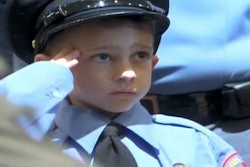The objects and papers of J. Edgar Hoover, who transformed the FBI from an administrative bureau into a modern federal law enforcement agency, will be available for public viewing at the National Law Enforcement Museum, when it opens in 2013.
Through a donation from the J. Edgar Hoover Foundation, the museum has acquired more than 2,000 items from Hoover's estate, including his office desk, chair and telephone, presentation items, awards, photographs, correspondence, books, recordings of speeches and numerous other items that relate to his personal and professional life, specifically his tenure as director of the FBI from 1924 to 1972.
"You can't tell the story of American law enforcement without telling the story of the FBI, and you certainly can't tell the story of the FBI without telling the story of J. Edgar Hoover," said Craig W. Floyd, chairman and CEO of the National Law Enforcement Officers' Memorial Fund (NLEOMF). "We are very proud that when the doors of the museum open, we will be able to tell the story of Director Hoover and the FBI like no one has been able to tell it before."
Floyd, FBI Assistant Director Michael Kortan and other officials made the announcement at a Wednesday news conference in D.C.
"The J. Edgar Hoover Foundation is indeed fortunate and most pleased that the National Law Enforcement Museum will serve as the repository for Mr. Hoover's estate," said William Branon, the foundation's chairman. "There is no more fitting venue to curate his items and to make them available for research as well as display to the public."
The museum also announced that its research facility will be named the J. Edgar Hoover Research Center, due to support from the J. Edgar Hoover Foundation; Society of Former Special Agents of the FBI; FBI National Academy Associates; National Executive Institute Associates; and the Society of FBI Alumni.
"The naming of the J. Edgar Hoover Research Center at the museum is a most fitting and lasting tribute to the legacy of a great American and the father of modern law enforcement," Branon added.
Included in the donation are the papers of Morris Childs, a longtime FBI spy inside the Communist Party USA from the end of World War II until 1980. In 1987, President Reagan awarded Childs the Presidential Medal of Freedom for his Cold War spy work.
This collection of personal papers includes correspondence, reports, notes, speeches, writings, and interview transcripts relating to FBI surveillance of the Communist Party (known as Operation SOLO) and the relationship between the Communist Party in the U.S. and the Soviet Communist Party and government. John Barron used this collection as research material for "Operation Solo: The FBI's Man in the Kremlin," published in 1996.
"The addition of the J. Edgar Hoover collection makes the National Law Enforcement Museum one of the 'go to' places for conducting research on Director Hoover and the FBI," said Laurie Baty, the Memorial Fund's senior director of museum programs.
She noted that the museum already is the repository for interview transcripts from the oral history program of the Society of Former Special Agents of the FBI. More than 200 transcripts of interviews are now available through the museum's online catalog.
The J. Edgar Hoover objects are the latest addition to the museum's growing collection, which now contains more than 10,000 artifacts documenting American law enforcement history.
Other highlights include: a sheriff's writ from 1703, the earliest object in the collection; artifacts associated with infamous crimes, such as the Lindbergh baby kidnapping case, and infamous criminals such as gangster Al Capone; handcuffs, nightsticks and other tools of the trade dating back to the 1850s; and pop culture items, such as the RoboCop movie costume and one of Jack Bauer's sweatshirts from the television show, "24."
The museum will also feature material from the Memorial Fund's files on the nearly 19,000 federal, state and local law enforcement officers in the United States who have died in the line of duty since the first death in 1792.
The National Law Enforcement Museum is a 55,000-square-foot, mostly underground museum that will be located adjacent to the National Law Enforcement Officers Memorial in D.C.'s Judiciary Square. The museum will tell the story of American law enforcement through high-tech, interactive exhibits, collections, research and education. Construction will begin Oct. 14, and the museum is projected to open in late 2013.











